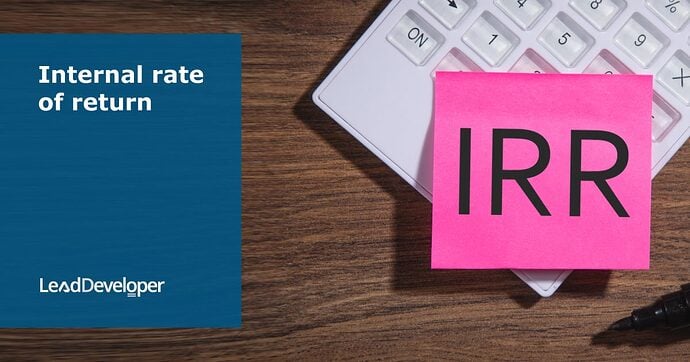Internal Rate of Return
Here is an in-depth explanation of the Internal Rate of Return (IRR), a crucial metric in finance and investment analysis. Here are the key points:
IRR Definition
IRR is the interest rate at which a project’s Net Present Value (NPV) equals zero. It represents the break-even cost of capital, beyond which a project would start to lose money.
Importance
IRR is used to evaluate the profitability of potential investments. It helps investors compare different investment opportunities based on their returns.
Equity vs. Project IRR
The video distinguishes between Equity IRR and Project IRR. Equity IRR considers the cash flow net of financing, reflecting the return on equity after accounting for debt. If a project is entirely equity-funded, both Equity IRR and Project IRR will match.
Leverage Impact
Using debt (leverage) can increase the return on equity by utilizing less of the investor’s money and more of the bank’s. However, if the project is fully funded by debt, Equity IRR does not exist.
Inflows & Outflows Analysis
The video explains how IRR calculations involve analysing cash inflows (returns) and outflows (costs and investments) and adjusting for debt financing and its costs.
Comparison with Debt Costs
Equity IRR can be less than Project IRR if the cost of debt is higher than the project’s IRR, indicating that debt holders would earn more from the investment than equity holders.
Insights based on numbers
- The concept of IRR revolves around finding a break-even point, expressed in percentages, which signifies a critical decision metric for investors.
- Leverage through debt affects the IRR by altering the ratio of equity to total investment, thereby impacting the overall return on equity.
- The difference between Equity IRR and Project IRR highlights the effect of financing structure on investment returns, emphasising the cost of debt as a pivotal factor.
Frequently Asked Questions
How does the IRR compare with other investment evaluation metrics like ROI or NPV?
IRR vs. ROI
IRR is a percentage rate that indicates the profitability of potential investments by determining the rate at which the net present value of costs (negative cash flows) of the investment equals the net present value of the benefits (positive cash flows). ROI, on the other hand, is a straightforward ratio that measures the gain or loss generated on an investment relative to the amount of money invested. ROI is easier to calculate but does not take into account the time value of money or the project duration as IRR does.
IRR vs. NPV
NPV is the calculation of the net present value of an investment’s cash flows by discounting them to the present using a discount rate (often the cost of capital). While NPV provides a dollar amount that represents the value added by the investment, IRR identifies the discount rate that makes the NPV equal zero. NPV can help in determining whether a project adds value or not, whereas IRR provides the break-even rate of return.
What are the limitations of using IRR for project evaluation, and how can they be addressed?
Multiple IRRs
For projects with alternating cash flows (positive and negative), there can be multiple IRRs, making it difficult to determine the true rate of return. This issue arises because the IRR equation is a polynomial that can have more than one solution.
- Solution
Use Modified Internal Rate of Return (MIRR), which assumes reinvestment at the project’s cost of capital or the firm’s reinvestment rate rather than the project’s own IRR.
Reinvestment Assumption
IRR assumes that all cash flows generated by the project are reinvested at the IRR itself, which might not be realistic, especially if the IRR is significantly high.
- Solution
MIRR addresses this by using a more realistic reinvestment rate, providing a better indication of the project’s profitability.
Scale and Timing
IRR does not account for the project scale (size of the investment) or the specific timing of cash flows, which can lead to misleading comparisons between projects.
- Solution
Evaluate projects using NPV in conjunction with IRR to consider the value added by the project and the timing of cash flows. NPV provides a dollar value that represents the project’s contribution to wealth, which can be a more comprehensive measure when combined with IRR.
In what scenarios is leveraging debt to improve Equity IRR not advisable?
High Cost of Debt Exceeds Project IRR
Leveraging is less advisable when the cost of the debt is higher than the project’s IRR. In such cases, the additional cost of debt reduces the overall profitability of the project and, consequently, the Equity IRR. This scenario means that the debt holders (banks or lenders) are effectively earning more from the project than the equity holders, making the project less attractive to investors.
Increased Financial Risk
Utilizing high levels of debt increases the financial risk of the project. In situations where market conditions are volatile, or the project’s cash flows are uncertain, the obligation to repay debt can jeopardise the project’s financial stability and the equity holder’s investment.
Project’s Capacity to Generate Stable Cash Flows
If a project is not expected to generate stable and sufficient cash flows to cover the debt payments and provide a return to equity investors, leveraging might not be advisable. Projects with high variability in earnings or those in industries with higher market risk may not be suitable candidates for high leverage.
Impact on Credit Ratings and Future Borrowing Capacity
Excessive leverage can adversely affect a company’s or project’s credit rating, making it more difficult or expensive to secure financing in the future. This scenario can limit growth opportunities and increase the cost of capital.
What is the Internal Rate of Return (IRR)?
The Internal Rate of Return (IRR) is a financial metric used to evaluate the profitability of a project or investment. It is defined as the interest rate that makes the Net Present Value (NPV) of all cash flows (both incoming and outgoing) from a particular project equal to zero. In simpler terms, it’s the rate of return at which an investment breaks even.
Why is IRR important in finance and investment analysis?
IRR is crucial for comparing the potential profitability of different investments or projects. It provides a single, standardised figure that reflects an investment’s return rate, helping investors and analysts determine which investment would yield the highest return relative to its cost.
What is the difference between Equity IRR and Project IRR?
Equity IRR and Project IRR are two ways of calculating the Internal Rate of Return, focusing on different aspects of investment returns. Equity IRR takes into account the cash flows net of financing, showing the return on equity after considering the cost of debt. It reflects the profitability of equity investors. Project IRR, on the other hand, considers the total cash flows without differentiating between equity and debt, reflecting the overall profitability of the project.
How does leverage affect IRR?
Leverage, or the use of borrowed money, can increase the return on equity by reducing the amount of the investor’s own money needed for the investment. However, leverage also introduces the cost of debt into the equation. If a project is fully funded by debt, there’s no Equity IRR since there’s no equity investment. The impact of leverage on IRR is significant as it alters the equity-to-total investment ratio, potentially increasing the financial risk while aiming to enhance returns.
Can Equity IRR be lower than Project IRR?
Yes, Equity IRR can be lower than Project IRR if the cost of debt is higher than the project’s overall IRR. This scenario indicates that the debt holders would earn a higher return on their investment compared to equity holders, emphasising the impact of financing costs on investment returns.
What insights can be gained from understanding IRR?
Understanding IRR offers critical insights into the financial viability and profitability of investments. It helps investors identify the break-even rate of return, compare different investment opportunities, and assess the impact of financing structures on returns. The distinction between Equity IRR and Project IRR further highlights how debt and equity financing affect the profitability metrics of an investment, guiding strategic financial decisions.
Test Your Knowledge
Multiple-Choice Questions on Internal Rate of Return (IRR)
1. What does the Internal Rate of Return (IRR) signify in investment analysis?
A) The maximum interest rate a project can handle before it becomes unprofitable.
B) The interest rate at which a project’s Net Present Value (NPV) equals zero.
C) The total return expected on an investment over its lifetime.
D) The annual growth rate of the investment’s profit.
2. Why is IRR considered an important metric in finance?
A) It shows the actual cost of the capital invested.
B) It indicates the break-even cost of capital for a project.
C) It helps investors compare the profitability of different investments.
D) It calculates the total interest paid over the life of the project.
3. What is the difference between Equity IRR and Project IRR?
A) Equity IRR is calculated before financing costs, while Project IRR is calculated after.
B) Project IRR considers only the equity portion of cash flows, whereas Equity IRR includes both equity and debt.
C) Equity IRR reflects the return on equity after accounting for debt, while Project IRR reflects the total project’s profitability.
D) There is no significant difference; they are interchangeable terms.
4. How does leverage impact Equity IRR?
A) It decreases Equity IRR since more debt means higher interest payments.
B) It has no effect on Equity IRR but affects Project IRR.
C) It increases Equity IRR by utilising more of the bank’s money and less of the investor’s.
D) It eliminates Equity IRR if the project is fully funded by debt.
5. In the context of IRR, what do analysing cash inflows and outflows entail?
A) Calculating the total cash inflows and comparing them with initial investment.
B) Determining the interest rates applied to cash inflows.
C) Adjusting for debt financing and its costs to find the project’s break-even point.
D) Estimating future cash flows without considering current investments.
6. Under what circumstance can Equity IRR be less than Project IRR?
A) If the project does not utilise any debt financing.
B) When the cost of debt is lower than the project’s IRR.
C) If the cost of debt is higher than the project’s IRR, indicating a higher return for debt holders.
D) Whenever a project is equity-funded.
7. What insight does the distinction between Equity IRR and Project IRR provide to investors?
A) It helps in understanding the fluctuation of market interest rates.
B) It emphasises the cost of debt as a critical factor in financing structure and investment returns.
C) It indicates that projects with high IRRs are always preferable.
D) It suggests that debt financing has no significant impact on investment returns.
Answers
- B - The interest rate at which a project’s Net Present Value (NPV) equals zero.
- C - It helps investors compare the profitability of different investments.
- C - Equity IRR reflects the return on equity after accounting for debt, while Project IRR reflects the total project’s profitability.
- C - It increases Equity IRR by utilising more of the bank’s money and less of the investor’s.
- C - Adjusting for debt financing and its costs to find the project’s break-even point.
- C - If the cost of debt is higher than the project’s IRR, indicating a higher return for debt holders.
- B - It emphasises the cost of debt as a critical factor in financing structure and investment returns.
Assignment
Practical Exercise on Understanding Internal Rate of Return (IRR)
Objective:
This assignment aims to deepen students’ understanding of the Internal Rate of Return (IRR) and its implications in evaluating investment opportunities. Students will apply concepts related to IRR, Equity IRR, and Project IRR to real-world scenarios, demonstrating their ability to analyze and compare investment options.
Part 1: Comprehension and Calculation
To Do
Calculate IRR
Imagine you are evaluating a project with the following cash flows: An initial investment of $100,000, followed by returns of $30,000, $40,000, $50,000, and $60,000 over the next four years. Calculate the project’s IRR.
Tools/Resources
Use any financial calculator or spreadsheet software capable of IRR calculations.
To Do
Equity IRR vs. Project IRR Scenario Analysis
Create a scenario where an investment of $200,000 yields returns of $60,000 annually over five years. Assume 50% of the project is financed through debt with an annual interest rate of 5%. Calculate both the Project IRR and the Equity IRR.
Discussion
Explain how and why the Equity IRR differs from the Project IRR in this scenario.
Part 2: Application and Analysis
Research and Reflect
Leverage Impact on IRR
Research an actual investment case or use a hypothetical scenario to illustrate how leveraging (using debt) affects the Equity IRR of an investment. Discuss the potential risks and benefits of using leverage in investment projects.
To Do
Comparison with Debt Costs
Create a table comparing two projects of your choice (real or hypothetical). For each project, list out the initial investment, expected annual cash flows, loan amount (if any), and loan interest rate. Calculate the IRR, Equity IRR (if applicable), and note if the cost of debt impacts the attractiveness of each project from an equity holder’s perspective.
Part 3: Critical Thinking and Discussion
To Do
Impact of Financing Structure on IRR
Discuss how changing the financing structure of a project (i.e., altering the ratio of debt to equity) can impact the Project IRR and Equity IRR. Provide examples with calculations to support your discussion.
Research Question
Real-World Application of IRR
Find and analyse a real-world investment decision where IRR was a key factor in the decision-making process. Discuss the outcome of the investment and whether the IRR accurately predicted the project’s success or failure.
Part 4: Presentation
To Do
Presentation of Findings
Prepare a presentation summarising your findings from the above tasks. Include calculations, tables, and any research findings. Present your analysis on how IRR, Equity IRR, and the financing structure impact investment decisions.
Submission Guidelines:
- Complete all parts of the assignment and compile your findings into a single document.
- For calculations, include detailed steps and formulas used.
- For research components, cite all sources appropriately.
- Prepare a presentation of 10-15 slides for Part 4.



